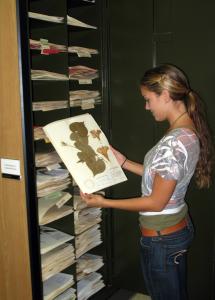Collaborative botanical research consortium receives $1.4 million grant
Research offers digital access to essential biological research collections
University of Hawaiʻi at MānoaContact:
Dr. Michael B. Thomas, (808) 956-4168
Collections Manager, Botany
Dr. Tom Ranker, (808) 956-8369
Departmental Chair, Botany
Collections Manager, Botany
Dr. Tom Ranker, (808) 956-8369
Departmental Chair, Botany
Posted: Jan 27, 2011
The University of Hawaiʻi at Mānoa’s Department of Botany, in collaboration with the Bernice P. Bishop Museum and National Tropical Botanical Garden, has received $1.4 million from the National Science Foundation (NSF) to develop a Consortium of Pacific Herbaria (CPH).
The CPH is based at UH Mānoa's Joseph Rock Herbarium and includes new collaborations between more than a dozen herbaria in Hawaiʻi, American Samoa, Samoa, Tonga, Palau, Guam, and Fiji. The network will manage plant and algal collections from the Polynesia-Micronesia biodiversity hotspot region. The Polynesia-Micronesia Hotspot (PMH) is a center of biodiversity that harbors approximately 5,350 native vascular plant species.
“The major goals of the CPH include curating and digitally imaging nearly one million dried plant specimens from Polynesia, Micronesia, and Fiji, creating a standardized plant checklist, and making collections data and digital images available online from a single web portal,” said Dr. Tom Ranker, Department of Botany chairperson.
"Increased access to digital data for plants and algae of the Pacific Basin through the CPH will create new regional research opportunities to discover and use collection data," added UH Manoa's Joseph F. Rock Herbarium Collections Manager, Dr. Michael Thomas. Thomas referred to the partnership as “a milestone opportunity for regional collection managers and scientists to work together offering digital access to essential biological research collections.”
The project will develop an authoritative checklist of Latin and common plant names that will facilitate the research of biologists and work of land-use managers who monitor invasive and endangered species throughout the Pacific. A new course in herbarium curation will be offered to college students in Hawaiʻi, and employment opportunities will be made available in regional herbaria to native Pacific Islanders. Plant identification workshops will be offered to professional biologists in the region, focusing on five common plant families that pose particular challenges for identifying Pacific species.
The CPH is based at UH Mānoa's Joseph Rock Herbarium and includes new collaborations between more than a dozen herbaria in Hawaiʻi, American Samoa, Samoa, Tonga, Palau, Guam, and Fiji. The network will manage plant and algal collections from the Polynesia-Micronesia biodiversity hotspot region. The Polynesia-Micronesia Hotspot (PMH) is a center of biodiversity that harbors approximately 5,350 native vascular plant species.
“The major goals of the CPH include curating and digitally imaging nearly one million dried plant specimens from Polynesia, Micronesia, and Fiji, creating a standardized plant checklist, and making collections data and digital images available online from a single web portal,” said Dr. Tom Ranker, Department of Botany chairperson.
"Increased access to digital data for plants and algae of the Pacific Basin through the CPH will create new regional research opportunities to discover and use collection data," added UH Manoa's Joseph F. Rock Herbarium Collections Manager, Dr. Michael Thomas. Thomas referred to the partnership as “a milestone opportunity for regional collection managers and scientists to work together offering digital access to essential biological research collections.”
The project will develop an authoritative checklist of Latin and common plant names that will facilitate the research of biologists and work of land-use managers who monitor invasive and endangered species throughout the Pacific. A new course in herbarium curation will be offered to college students in Hawaiʻi, and employment opportunities will be made available in regional herbaria to native Pacific Islanders. Plant identification workshops will be offered to professional biologists in the region, focusing on five common plant families that pose particular challenges for identifying Pacific species.
For more information, visit: http://www.herbarium.hawaii.edu/

